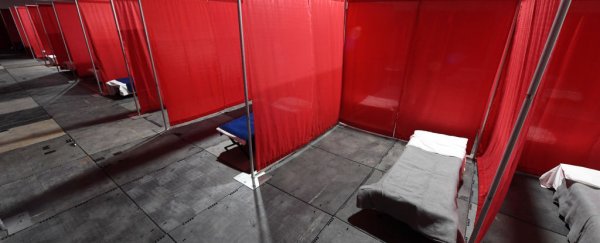Robert Redfield, the Director of the Centres for Disease Control and Prevention, said Tuesday that while the US appeared to be nearing the peak of cases for the current COVID-19 outbreak, a second wave could be even worse.
In an interview with The Washington Post, Redfield said another outbreak of the novel coronavirus in winter could be more disastrous because of the strain it would place on hospitals, even if preparation and treatment options improve.
"There's a possibility that the assault of the virus on our nation next winter will actually be even more difficult than the one we just went through," Redfield said.
"And when I've said this to others, they kind of put their head back; they don't understand what I mean."
The novel coronavirus was first identified in Wuhan, China, in early January. After outbreaks in several Asian countries, Iran, and Italy, the US saw confirmed cases of COVID-19, the disease caused by the virus, surge beginning in early March.
Redfield told The Post that if the virus had hit the US a few months earlier at the height of flu season, "it could have been really, really, really, really difficult in terms of health capacity."
Already, hospital systems in major hot spots like New York City are overwhelmed with patients and, in many cases, lack the necessary medical equipment like ventilators and personal protective gear for healthcare workers.
Redfield said that a winter outbreak of COVID-19 would be particularly catastrophic for hospitals and medical systems when layered on top of the usual winter flu season and higher rates of other illnesses that are more prevalent in the winter months, including pneumonia and bronchitis.
The coronavirus is both more contagious and more deadly than seasonal influenza, and a vaccine against it almost certainly won't be available by the time flu season comes around.
While some clinical trials for coronavirus treatments are showing encouraging signs, the US is still likely 12 to 18 months away from developing a deployable vaccine.
Because of that, Redfield said, it will be more important than ever for people to get their flu shots to reduce their risk and help lessen the burden on the healthcare system. He told The Post that more people getting vaccinated against the flu "may allow there to be a hospital bed available for your mother or grandmother that may get coronavirus."
In an April 9 town hall with CNN's Anderson Cooper and Sanjay Gupta, Redfield said that while the US has a long way to go to end the outbreak, the rate of infection is set to reach its peak soon thanks to widespread aggressive mitigation measures, such as the stay-at-home orders strictly imposed in the majority of states and the shuttering of nonessential businesses.
"One of the critical things clearly has been the aggressive social distancing we've done," Redfield said. "I think we're seeing the consequences of that when we see that our mortality rate is really a lot lower than what would have been predicted, and it really shows that mitigation works."
He added: "Clearly, as we move to reopen – and I think we're coming to the peak as we sit here today, where we're able to see the other side of the curve, and we'll see this outbreak continue to decline over the weeks ahead – we need to understand the extent of the transmission of the virus."
Both on CNN and in his interview with The Post, Redfield emphasised that in the absence of a vaccine, the US will need to both massively scale up its testing regimen and heavily invest in contact tracing to track how the disease is progressing.
To do that, Redfield told The Post that the CDC was in preliminary talks to work with other federal agencies, including the Census Bureau, AmeriCorps, and the Peace Corps, to create an entire "alternative workforce" dedicated to comprehensive contact tracing, which would require hundreds of thousands of workers nationwide.
"These are all discussions that are going on to try to determine what is the optimal strategy to be used," Redfield said.
"And it may be some combination of all three."
This article was originally published by Business Insider.
More from Business Insider:
